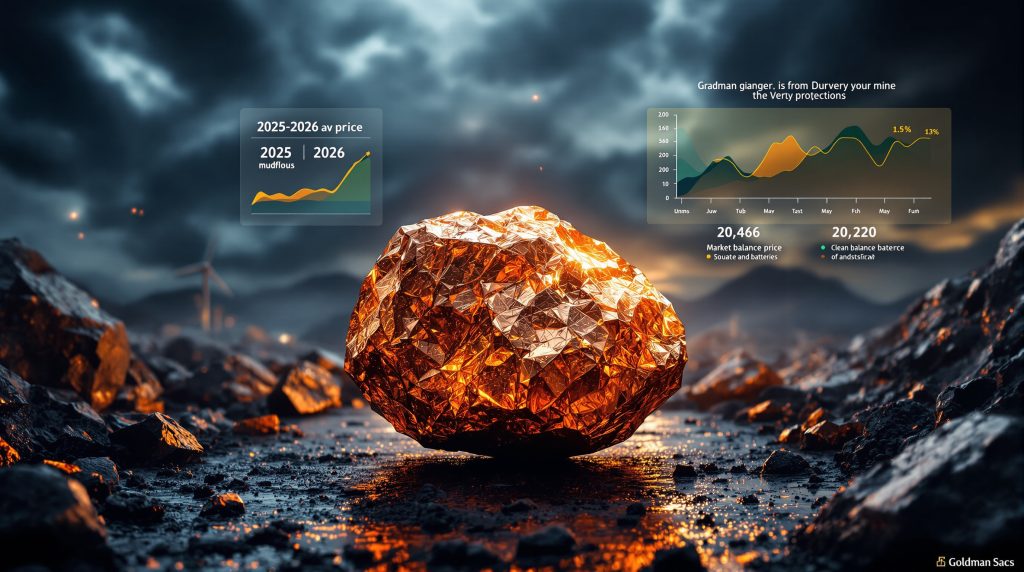Goldman Sachs Copper Forecast Downgrade: What Does It Mean for the Market?
The recent disruption at Indonesia's Grasberg mine has prompted Goldman Sachs to significantly revise its global copper supply outlook. Following the September 8 incident where workers became trapped underground due to heavy mud flow, Freeport-McMoRan declared force majeure at what is the world's second-largest copper mine. This unexpected event has created ripple effects throughout the global copper supply outlook.
Goldman Sachs now estimates a total production loss of approximately 525,000 metric tons of copper, with impacts stretching well into 2026. This substantial reduction has forced analysts to recalibrate their supply projections for both the immediate and medium-term future.
Revised Production Estimates for Grasberg
The production impact at Grasberg itself is expected to be severe:
-
2025 production is projected to fall by 250,000-260,000 tons
-
2026 production is estimated to decrease by approximately 270,000 tons
-
Q4 2025 production will be particularly affected, with output expected to be "very low"
According to Goldman Sachs' analysis of Freeport's communications, only about 30-40% of Grasberg's annual production capacity remains unaffected by the incident. These unaffected areas might restart operations by mid-fourth quarter of 2025, while the remainder of the mine is not expected to resume production until sometime in 2026.
What Are the Global Implications for Copper Supply?
The Grasberg disruption has forced a significant downward revision of global copper mine supply forecasts. Goldman Sachs has reduced its projections for:
-
Second half of 2025: Reduced by 160,000 tons
-
Full year 2026: Reduced by 200,000 tons
These adjustments have dramatically altered the expected growth trajectory for global copper production:
| Year | Previous Growth Forecast | Revised Growth Forecast |
|---|---|---|
| 2025 | +0.8% year-over-year | +0.2% year-over-year |
| 2026 | +2.2% year-over-year | +1.9% year-over-year |
The magnitude of the Grasberg disruption exceeds Goldman's typical allowances for global supply disruptions, highlighting the significance of this single event on worldwide copper availability.
How Will This Affect the Copper Market Balance?
Perhaps most significantly, the supply reduction has flipped Goldman Sachs' projection for the 2025 global copper market from surplus to deficit:
| Year | Previous Market Balance | Revised Market Balance |
|---|---|---|
| 2025 | 105,000 ton surplus | 55,500 ton deficit |
| 2026 | Small surplus | Small surplus (reduced) |
This shift from surplus to deficit represents a fundamental change in market dynamics that could have significant implications for pricing and market behavior throughout 2025 and into 2026.
The 160,500-ton swing from surplus to deficit is particularly noteworthy as it demonstrates how a single disruption at one major mine can dramatically alter global market fundamentals. Market participants will need to adjust their strategies accordingly as the copper landscape transforms from one of relative abundance to one of constraint.
What Does This Mean for Copper Prices?
The supply disruption has created upward pressure on Goldman Sachs copper forecast downgrade. The bank now sees:
-
Upside risks to its December 2025 London Metal Exchange (LME) copper price forecast of $9,700 per ton
-
Potential for prices to settle in the $10,200-$10,500 range instead
-
Reaffirmation of its long-term bullish outlook of $10,750 per ton by 2027
These price projections reflect the tightening supply situation and underscore the market's sensitivity to major disruptions at key production sites.
The current LME copper price of $10,277.50 per ton already sits within Goldman's projected range, suggesting that traders have begun pricing in the supply constraints. Historical precedent shows that unexpected supply disruptions of this magnitude typically lead to price volatility as market participants reassess their positions.
Why Is the Copper Market Facing Ongoing Supply Challenges?
The Grasberg disruption is not occurring in isolation. Goldman Sachs points to several structural challenges affecting copper supply:
Operational Challenges
-
Deeper mines requiring more complex extraction techniques
-
Declining ore grades across many major deposits
-
Harder ore extraction conditions increasing operational complexity
The declining quality of accessible copper deposits represents a long-term constraint on supply growth. As miners exhaust easily accessible resources, they must invest more capital and technology to maintain production levels, creating a structural upward pressure on costs.
Additional Recent Disruptions
-
Issues at the Kamoa-Kakula mine complex
-
Disruptions at the El Teniente mine
These factors collectively contribute to a challenging supply environment that makes the market particularly vulnerable to major disruptions like the one at Grasberg. Furthermore, the ongoing trade war impact on copper adds another layer of complexity to the market dynamics.
What Are the Long-Term Implications for Copper Supply?
While the immediate focus is on the Grasberg disruption, the incident highlights broader concerns about copper supply resilience. The industry faces several long-term challenges:
-
Aging infrastructure at many major mining operations
-
Environmental and social permitting challenges for new projects
-
Water scarcity affecting operations in key copper-producing regions
-
Increasing technical complexity of accessing remaining copper reserves
These structural issues suggest that supply disruptions may become more common, potentially supporting Goldman Sachs' bullish long-term price outlook.
The copper industry's vulnerability extends beyond operational risks to include geopolitical factors, resource nationalism, and climate-related challenges. Mining companies must navigate these complexities while investing in technological innovations to maintain production levels and expand capacity.
How Are Copper Markets Responding?
As of the latest trading data, the benchmark three-month copper price on the London Metal Exchange was at $10,277.50 per ton, reflecting the market's incorporation of these supply concerns into current pricing.
The price movement suggests that traders are already factoring in the potential for continued supply tightness, aligning with Goldman Sachs' revised outlook.
Trading volumes and market liquidity will be important indicators to watch in the coming weeks as participants adjust their strategies to account for the new supply reality. According to Goldman Sachs' downgraded copper supply forecast, significant supply disruptions lead to increased hedging activity and strategic position-taking by both producers and consumers.
What Should Investors and Industry Participants Watch For?
Given the evolving situation at Grasberg and the broader supply challenges, several key indicators will be important to monitor:
-
Updates from Freeport-McMoRan regarding restart timelines
-
Production reports from other major copper mines for signs of additional disruptions
-
Inventory levels at major exchanges as an indicator of immediate market tightness
-
Chinese demand patterns, as the world's largest copper consumer
-
Development timelines for major new copper projects that could offset supply losses
These factors will collectively determine whether the current supply constraints persist or if the market can find a new equilibrium in the coming years. Additionally, rising copper demand trends will play a crucial role in shaping the market's response to these supply challenges.
Market participants should pay particular attention to inventory trends at the LME, COMEX, and Shanghai Futures Exchange. Declining inventories would signal that the supply deficit is materializing as projected, while inventory builds might indicate weaker demand or additional supply from previously undiscounted sources.
Conclusion: A Tightening Copper Market Ahead
The Goldman Sachs forecast downgrade following the Grasberg mine disruption signals a significant shift in copper market dynamics. The transformation from an expected surplus to a projected deficit in 2025 highlights the fragility of global copper supply chains and their vulnerability to major disruptions.
For investors, manufacturers, and other stakeholders in the copper market, this development underscores the importance of supply chain resilience and the potential for sustained price support in the medium term. As the clean energy transition continues to drive copper demand, these supply challenges may become increasingly significant in shaping market dynamics.
The copper market's sensitivity to supply disruptions is heightened by its crucial role in electrification trends. With limited substitutes available for many applications, consumers have little choice but to adjust to higher prices when supply constraints emerge. For more detailed insights on price movements and market trends, readers can explore copper price forecast insights.
Further Exploration
Readers interested in learning more about global copper market dynamics can explore related educational content from Mining Weekly, which offers regular updates on developments in the mining sector and commodity markets.
The interaction between copper supply challenges and growing demand from renewable energy, electric vehicles, and grid modernization efforts creates a complex market environment that requires ongoing analysis and strategic planning. As the Grasberg situation continues to evolve, market participants would be wise to monitor developments closely and adjust their strategies accordingly. Those interested in understanding the investment landscape might also benefit from examining US copper investment insights for a broader perspective on market developments.
Looking for Early Insights on Major Mineral Discoveries?
Don't miss out on the next significant copper discovery before it makes headlines. Discovery Alert's proprietary Discovery IQ model delivers real-time notifications on ASX mineral discoveries, giving you a crucial market advantage on commodities like copper. Visit our dedicated discoveries page to see how early alerts on major finds have historically led to exceptional investment returns.




